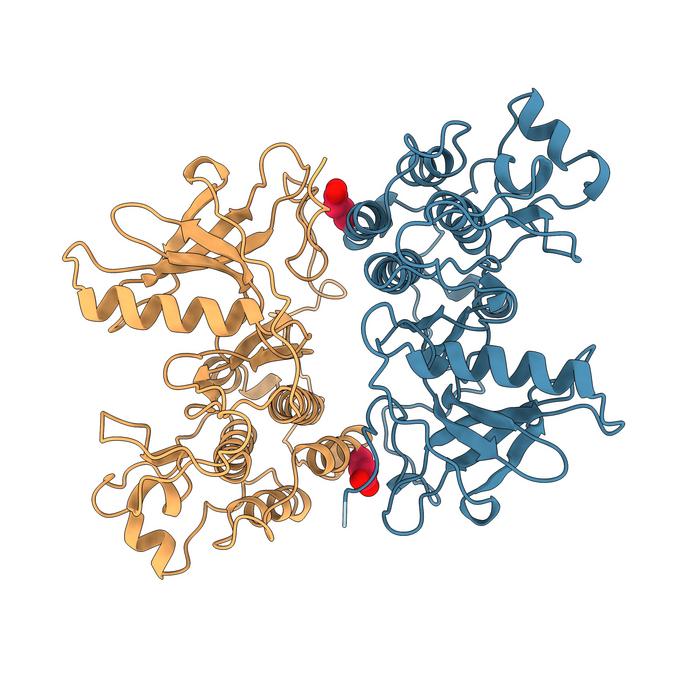
Scientists identify Achilles heel of lung cancer protein
Researchers have shown for the first time that a crucial interface in a protein that drives cancer growth could act as a target for more effective treatments.

Credit: Ioannis Galgadas, University of Geneva
Researchers have shown for the first time that a crucial interface in a protein that drives cancer growth could act as a target for more effective treatments.
The study was led by the Science and Technology Facilities Council (STFC) Central Laser Facility (CLF) and used advanced laser imaging techniques to identify structural details of a mutated protein which help it to evade drugs that target it.
It is published (19/03/2024) in the journal, Nature Communications and lays the groundwork for future research into more effective, long-lasting cancer therapies.
The Epidermal Growth Factor Receptor (EGFR) is a protein that sits on the surface of cells and receives molecular signals that tell the cell to grow and divide. In certain types of cancer, mutated EGFR stimulate uncontrolled growth, resulting in tumours.
Various cancer treatments block and inhibit mutant EGFR to prevent tumour formation, but these are limited as eventually cancerous cells commonly develop further EGFR mutations that are resistant to treatment.
Until now, how exactly these drug-resistant EGFR mutations drive tumour growth was not understood, hindering our ability to develop treatments that target them.
In this latest study, scientists at CLF have obtained super-resolution images of a drug-resistant EGFR mutation known to contribute to lung cancer. This was achieved using an advanced laser imaging technique developed by STFC for this purpose called Fluorophore Localisation Imaging with Photobleaching, or FLImP.
FLImP analysis revealed structural details as small as two nanometres and showed for the first time with this level of precision how molecules in the drug-resistant EGFR mutation interact.
Additional analysis by the Biomolecular & Pharmaceutical Modelling Group at University of Geneva (UNIGE) used advanced computer simulations that combined with the FLImP analysis were able to provide atomistic details of the mutant EGFR complexes.
From this, the team were able to compare the structural details of the mutated and healthy EGFR to identify interfaces between interacting molecules in the drug-resistant mutation critical for tumour growth.
Professor Marisa Martin-Fernandez, Leader of the Octopus Group at CLF, which led the study, said: “This finding is the culmination of years of research and technological development at CLF and our partner institutions and we’re extremely excited about its potential to inform the course of cancer research going forward. If this interface proves to be an effective therapeutic target, it could provide an entirely new approach to much needed pharmaceutical development.”
The team then introduced additional mutations to the drug-resistant EGFR in in cultured lung cells and in mice that interfered with the newly discovered interfaces.
In these experiments, one of the additional EGFR mutations was shown to block cancer growth, with mice developing no tumours, further indicating that the ability of this EGFR mutation to promote cancer indeed depends on these interfaces.
Dr Gilbert Fruhwirth, Leader of the Imaging Therapies and Cancer group at King’s College London who validated results in live animals, said: “This research has become possible through the combination of a variety of different imaging technologies, ranging from single molecules to whole animals, and demonstrates the power of imaging to better understand the inner workings of cancer. We are extremely pleased about this successful collaboration and look forward to develop this pharmaceutical opportunity further as part of this team.”
Researchers hope that these interfaces could act as potential targets for new cancer therapies that overcome resistance acquired by EGFR mutations.
Professor Francesco Luigi Gervasio, Leader of the Biomolecular & Pharmaceutical Modelling Group at UNIGE, said: “This breakthrough was made possible by a combination of state-of-the-art simulations and experimental techniques that can now ‘visualise’ the structure and dynamics of important cancer targets such as EGFR in unprecedented detail.”
Dr. Yiannis Galdadas at UNIGE, who performed the simulations, said: “The simulations were able to push the effective resolution of the microscope beyond the limits of imagination. It’s almost possible to ‘touch’ the mutation site and see its effect.”
Further studies at CLF are currently testing the research method on other EGFR mutations known to contribute to lung cancer. They also hope to establish whether this interface plays a role in the development of other cancers including brain cancer.
Notes to editors
The full paper can be read in Nature Communications (DOI 10.1038/s41467-024-46284-x): https://www.nature.com/articles/s41467-024-46284-x
For any enquiries and interview requests, or for an embargoed copy of the paper, please contact:
Alex Fyans
Research Media Manager
Science and Technologies Facilities Council
Email: [email protected]
Mobile: 07518 299 657
About the Central Laser Facility
The Central Laser Facility (CLF) at the STFC Rutherford Appleton Laboratory is one of the world’s leading laser facilities, providing scientists from the UK and Europe with an unparalleled range of state-of-the-art laser technology. CLF’s wide-ranging applications include experiments in physics, chemistry, and biology, accelerating subatomic particles to high energies, probing chemical reactions on the shortest timescales, and studying biochemical and biophysical process critical to life itself.
About the Science and Technology Facility Council
The Science and Technology Facilities Council (STFC), part of UK Research and Innovation (UKRI), is the UK’s largest public funder of research into particle and nuclear physics, astronomy and astrophysics, and space science. We operate five national laboratories across the UK which, supported by a network of additional research facilities, increase our understanding of the world around us and develop innovative technologies in response to pressing scientific and societal issues. We also facilitate UK involvement in a number of international research activities including CERN, the James Webb Space Telescope, and the Square Kilometre Array Observatory.
Journal
Nature Communications
DOI
10.1038/s41467-024-46284-x
Method of Research
Experimental study
Subject of Research
Animals
Article Title
Drug-resistant EGFR mutations promote lung cancer by stabilizing interfaces in ligand-free kinase active EGFR oligomers
Article Publication Date
19-Mar-2024